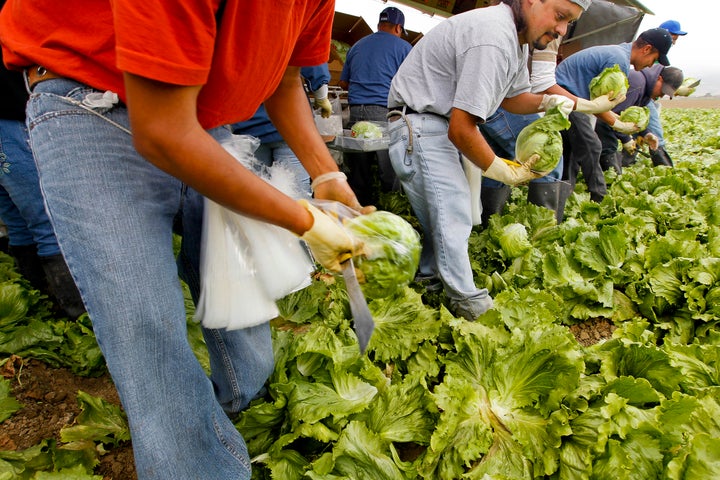It seems 2018 was the year of lettuce recalls. E. coli outbreaks rocked grocery store shelves, salad joints and refrigerators in the spring and then again in the fall.
“Lettuce romaine calm,” the pun nerds announced. “Marked safe from romaine lettuce,” joked the Facebook memes. “If you really think the media is fake news, now is your chance to prove it: eat all the lettuce,” laughed folks on Twitter.
And now that the government shutdown has postponed many of the FDA’s food inspections, we’re more in the dark than ever.
In the grand scheme of foodborne illness outbreaks, why is lettuce the dirtiest vegetable? Well, it isn’t ― it just seemed like that this past year.
“We don’t know if lettuce really is more susceptible to food safety issues than other products,” said Paula Rivadeneira, an assistant professor and extension specialist in food safety and wildlife at the University of Arizona Cooperative Extension in Yuma, Arizona.
Yuma grows 90 percent of the lettuce eaten in the United States during winter and was singled out as where the lettuce in the spring 2018 recall had come from. (Fall’s recall was from California.) It was the Yuma lettuce industry’s first foodborne illness outbreak, in part because of the hard work people like Rivadeneira put into protecting our food supplies. In fact, she told HuffPost, “We don’t know if lettuce really is more susceptible to food safety issues than other products or if we are just getting better at detecting it.”
“The nature of lettuce consumption brings it a lot of media attention: Not only is it eaten raw but it’s eaten very often.”
Recalls and food safety alerts come out in industry news almost daily, Rivadeneira explained, but most don’t surface to the wider public. They run the whole gamut of fresh produce, meat and dairy.
“There will never be zero risk when it comes to food that is grown naturally,” she explained. “These products are grown outside in the open air with open water sources and nature all around.” This is true of plenty of other vegetables, too, but the nature of lettuce consumption brings it a lot of media attention: Not only is it eaten raw but it’s eaten very often.
The farmers do what they can, even testing for pathogens before harvest. But, with the way our food system works, a lot of people have to touch the produce before it gets to your kitchen: It gets washed, processed, bagged, transported, handled and moved in and out of a number of locations. “There are a lot of places along that chain where contamination could happen,” she admitted.
Lettuce, of course, seems significant, in part because of how much we eat ― lettuce is a $1.5 billion industry and the U.S. produced more than 7.6 billion pounds in 2017. But it also affects us because we eat it raw, so there often isn’t an opportunity to cook out the pathogens.

Years ago, I interviewed the country’s premier food safety lawyer, Bill Marler, for Lucky Peach, and asked what foods he personally avoids. He said basically anything raw: raw milk, unpasteurized juices, raw shellfish, sprouts. And more than anything, bagged salad. “I look at bagged salad like swimming in a public swimming pool with 500 people ― you have no idea who they are ― versus taking a head of lettuce and washing it, which is like taking a bath with your significant other. It’s not without risks, but the risks are very, very small.”
In fact, one of the main difficulties in pinpointing the source of the romaine recall was that the people who contracted E. coli did so from chopped romaine, which processors had sourced from multiple farms. That means every head of lettuce grown needs to be pristine in order to prevent widespread outbreaks.
Rivadeneira’s team in Yuma helps to make sure all the growers follow the regulations from the Food Safety Modernization Act’s Produce Safety Rule, as well as the Leafy Green Marketing Agreement. Those standards include a slew of procedures relating to cleaning and sanitation, worker training and hygiene, preventing animals from getting access to the fields, using biological soil amendments, managing irrigation and any water used post-harvesting. But beyond that, they experiment with cutting-edge and out-of-the-box ideas, such as the use of falconry to prevent nuisance birds from contaminating fields and installing barn owl boxes to reduce rodent populations without the use of rodenticides.
But even with all that, one bad actor, like a stray bird dropping feces over a field in California, or something more systemic, like a cattle lot upstream from the water supply (one possible source for the Yuma outbreak), can cause a major issue. When it comes to preventing future outbreaks, Marler spends about half of his time advocating for national changes in regulations and policies, while Rivadeneira develops systems, strategies and programs on the ground for the Yuma growers.
But what can you, a lettuce consumer, do to keep yourself safe? Rivadeneira says that simply rinsing your produce with water will just move bacteria around; it won’t actually remove it.
She recommends using a vinegar-and-water solution, which is often made with a ratio of 3-to-1. Rivadeneira adds 1 cup of distilled white vinegar in a 32-ounce spray bottle and then fills it with tap water and adds a squirt of lemon juice “just because it smells good.” You can spray it on and leave it or let it soak in a clean sink in the vinegar-and-water solution for two minutes, then rinse it off with tap water ― “All bacteria will be gone, as long as you did it properly,” she says.
